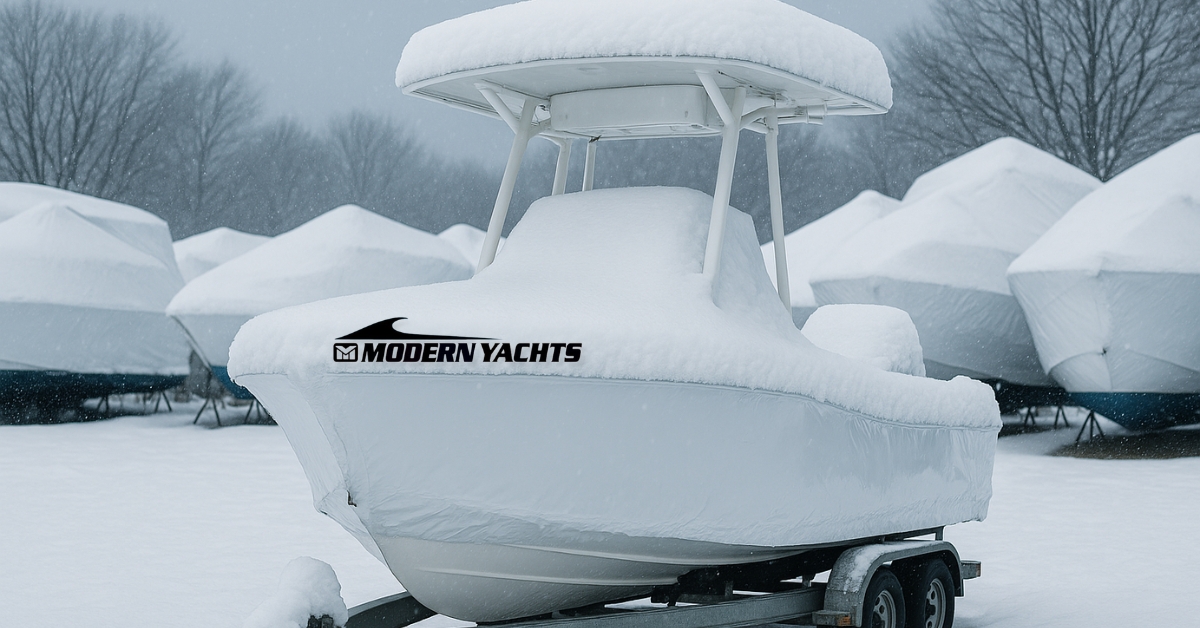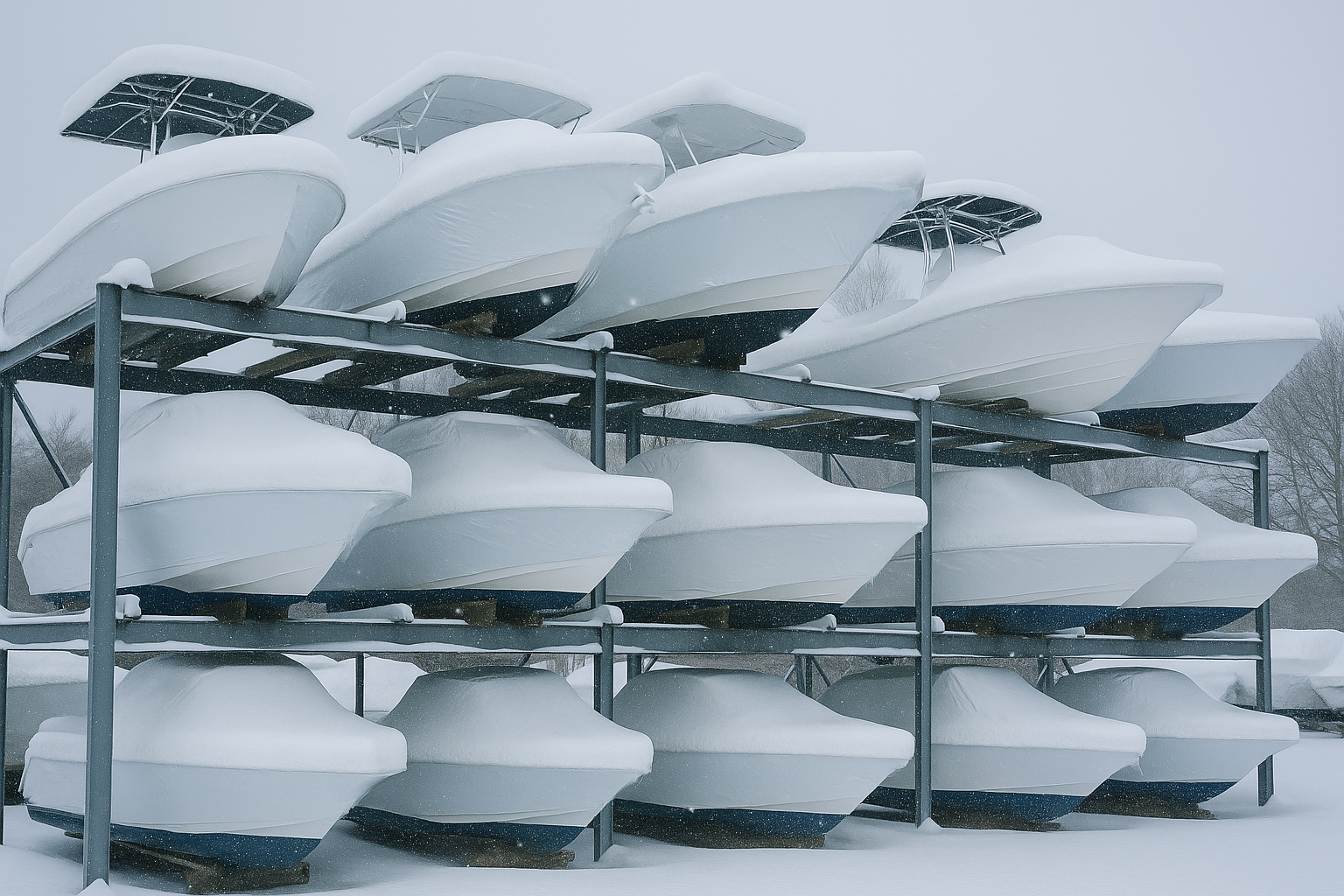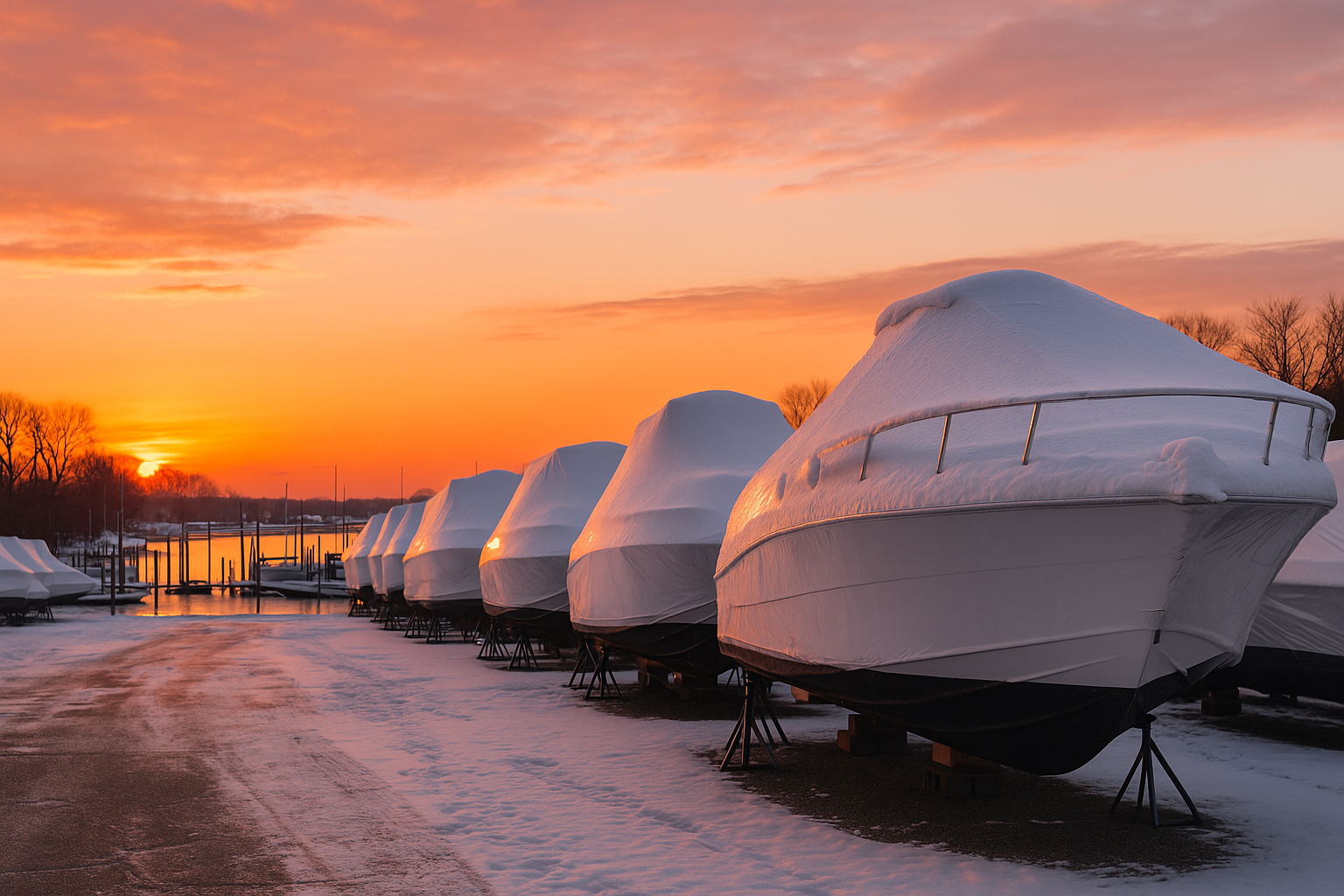As the boating season winds down, proper winterization and storage become essential.
Winterizing and storing your boat correctly will protect it from freezing temperatures, corrosion, and long-term wear — ensuring a smooth return to the water when spring arrives.
Whether you own a center console, sport cruiser, or luxury dayboat, following these expert tips from Modern Yachts will help safeguard your investment through the off-season.
Flush and Protect the Engine
Start by flushing your engine with fresh water to remove salt, sand, and debris. Then, run non-toxic marine antifreeze through the system to prevent internal freezing and corrosion.
For outboards, disconnect the fuel line, let the engine run dry, and apply fogging oil to moving parts. Inboards and stern drives should also have oil and filters changed to eliminate moisture and acid buildup that can cause damage during storage.
Pro Tip: Always follow manufacturer guidelines or schedule winterization service with Modern Yachts’ certified technicians to ensure every component is protected.
Stabilize and Fill the Fuel System
Add a marine-grade fuel stabilizer to your tank and run the engine long enough for it to circulate. This prevents fuel breakdown and keeps injectors, carburetors, and fuel lines clear.
Keep the tank nearly full to reduce condensation, but leave a little room for expansion.
Drain and Protect Freshwater Systems
If your boat has freshwater systems, sinks, or a head, drain them completely and run non-toxic antifreeze through the lines, pumps, and holding tanks. Don’t forget bilge pumps and livewells — these are often overlooked but equally at risk of freezing.
Clean, Dry, and Wax the Exterior
Wash your hull, deck, and topsides thoroughly to remove salt and grime. Once dry, apply a quality marine wax to protect your gelcoat and paint from oxidation.
Cleaning before storage also prevents mold, mildew, and corrosion from forming during the winter months.
Remove and Store Electronics and Gear
Take out electronics, safety equipment, seat cushions, and valuables. Store them indoors in a dry, temperature-controlled space to protect them from moisture and theft.
Choose the Right Storage Method
You have two main options for winter boat storage: indoor and outdoor.
- Indoor Storage: Offers the best protection from the elements, keeping your boat dry and secure all winter.
- Outdoor Storage: Ideal when space is limited, but it’s critical to use professional shrink wrap or a fitted cover to keep out snow, rain, and UV rays.
If storing outdoors, make sure your boat is on a trailer or stands with proper hull support and drainage.
Ventilation and Moisture Control
Even when covered, airflow is key. Use vents or moisture-absorbing materials (like DampRid or desiccant bags) to prevent mold and mildew from developing inside the cabin or compartments.
Inspect and Maintain Batteries
Disconnect and remove your batteries before storage. Store them in a cool, dry location and charge them periodically throughout the winter. This simple step can dramatically extend battery life and performance.
Schedule a Professional Inspection
Before officially storing your boat, consider a winterization and storage inspection from Modern Yachts. Our certified service team checks all key systems — mechanical, electrical, and safety — to ensure your boat is fully prepped for off-season storage and ready to launch when spring returns.
Final Thoughts
Winterizing and storing your boat properly saves you time, money, and frustration come spring. From protecting your engine and fuel system to ensuring your boat stays dry and covered, these steps are essential to maintaining performance and longevity.
For expert help with winterization, shrink wrapping, or off-season storage, contact Modern Yachts today. Our team proudly serves Long Island boaters with locations in Hampton Bays, Westhampton Beach, and Mattituck.
Additional Resources
For more in-depth guidance on winterizing and storing your boat, explore these trusted boating resources:
- BoatUS: How to Winterize Your Boat — A comprehensive step-by-step overview from one of the most respected names in boating.
- Mercury Marine: Winterization Tips — Official maintenance recommendations from a leading marine engine manufacturer.
- Discover Boating: Boat Storage Options — Compare indoor vs. outdoor storage methods and learn how to choose what’s right for your vessel.
- U.S. Coast Guard Boating Safety Resource Center — Safety tips and checklists for maintaining your boat and onboard systems.
- 3M Marine Products — Surface care and protection products to help keep your hull and finishes in top condition year-round.
FAQ’S
The ideal time to winterize your boat on Long Island is before the first consistent freeze, typically in late October or early November. Winterizing too late can lead to freezing damage in your engine or plumbing systems, while doing it early ensures your boat is fully protected when temperatures drop.
Yes. Even in indoor or heated storage, your boat’s systems still contain water and fuel that can degrade or cause damage over time. Proper winterization ensures the engine, fuel system, and plumbing remain corrosion-free and ready to start in the spring.
Whenever possible, store your boat indoors in a dry, climate-controlled space. If that’s not available, outdoor storage with professional shrink wrapping and proper ventilation works well. Make sure your hull is evenly supported and the cover is tight to prevent pooling or moisture buildup.
Yes. It’s best to disconnect and remove your batteries before storage. Store them in a cool, dry place and charge them every month or two to maintain performance. Leaving batteries connected can cause slow discharge or corrosion at the terminals.
Absolutely. Modern Yachts provides comprehensive winterization and storage solutions for all types of boats — from center consoles to cruisers and luxury dayboats. Our certified technicians handle everything from shrink wrapping and antifreeze application to full engine and systems inspection.
Contact us today or visit one of our Long Island locations in Hampton Bays, Westhampton Beach, or Mattituck to schedule your service.


